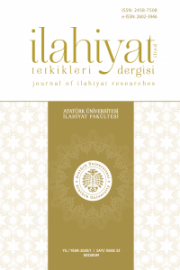بناء مقياس لمعرفة الميول المذهبيّة وتطبيقه
The Construction and Application of Using a Scale to Measure Islamic Doctrinal Behavior Tendency
Author(s): Mohammad Jaber ThalgiSubject(s): Law, Constitution, Jurisprudence, Theology and Religion, Islam studies, Canon Law / Church Law
Published by: Atatürk Üniversitesi İlahiyat Fakültesi
Keywords: Doctrinal Disposition; Measure of Doctrine; Purity; Prayer; Islamic Education; Jurisprudence;
Summary/Abstract: This study aimed to construct and apply a scale to measure the doctrinal trends of a sample of Yarmouk University students, by using well-known doctrinal issues in purity and prayer topics from the four Islamic Sunni jurisprudence doctrines, namely, Ḥanafī, Mālikī, Shāfiīʿ, and Ḥanbalī. The study adopted an inductive method to select the jurisprudential issues and analytical descriptive methodology and used the questionnaire as a method to build the syllabus and apply it to the sample. The results of the study show that there are doctrinal distinctions between the students based on their home countries and regions. The results show, also, that most students mix more than one doctrine in their application of purity and prayer. More specifically, the results show that Jordanian students tend to use two doctrines, namely, Ḥanbalī and Shāfiīʿ; the Turkish students tend to follow two doctrines, namely, Ḥanafī and Shāfiīʿ; and Chinese students turn to three doctrines, namely, Ḥanafī, Shāfiīʿ, and Ḥanbalī. In South African countries, students turn to Shāfiīʿ in most cases and, then, Mālikī and Ḥanbalī in some cases. Thai and Malaysian students prefer Shāfiīʿ in most cases.
Journal: İlahiyat Tetkikleri Dergisi
- Issue Year: 2020
- Issue No: 53
- Page Range: 187-211
- Page Count: 25
- Language: Turkish

